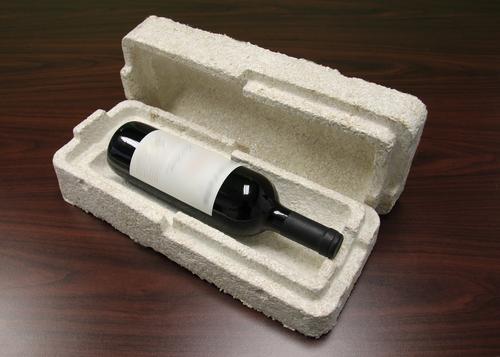Video: Mushrooms, Agricultural Waste Turned Into Eco-Friendly Packaging
Mushrooms are best known for their culinary and recreational “magic” uses (don't try this at home), but a former Vermont farmer has found a different way to use the popular fungi -- in the production of biodegradable, eco-friendly packaging that can replace Styrofoam and other synthetic foams.
February 6, 2015
Ecovative Design, based in Green Island, NY, has developed Mushroom Materials, which combines agricultural waste with a bonding material found in mushrooms called mycelium to create a foam-like material made entirely of natural products.

Mushroom Materials from Ecovative is a biodegradable, eco-friendly alternative to Styrofoam for providing packaging buffers for items like wine, appliances, and furniture. The material uses a combination of agricultural waste and mycelium, part of the root structure of mushrooms, to form the material. Pictured is the material being used as protective packaging for a wine bottle.
(Source: Ecovative Design)
Eben Bayer, the company’s co-founder, was inspired to develop the material after noticing how mycelium clumped wood chips together on the farm he grew up on in Vermont, said Melissa Jacobsen, director of First Impressions for the company.
“On the farm, one of his duties was to shovel wood chips into the maple syrup gasifier, where he would sometimes encounter clumps of wood chips being held together by the root structure of mushrooms,” she told Design News. “This was his first exposure to mycelium's ability to act as a natural glue.”
Years later when he was studying at Rensselaer Polytechnic Institute (RPI), Bayer explored the use of mycelium for a project to create a better, non-plastic form of insulation, and later teamed up with Ecovative co-founder Gavin McIntyre and RPI Professor Burt Swersey to commercialize the prototypes he developed, Jacobsen said.
Now Ecovative sells Mushroom Materials around the world as an alternative to synthetic foams in creating packaging buffers that protect items like wine, televisions, or furniture during packing and shipping. The materials also have been used in the construction of buildings and surfboards. Ecovative also is eyeing Mushroom Materials’ use for Styrofoam food containers, but it has not yet been certified for coming into contact with food.
Related articles on DesignNews.com
{doclink 271915}
{doclink 271999}
{doclink 257631}
{doclink 267392}
{doclink 274575}
Ecovative works locally with farms to collect agricultural material -- in this case, corn stalks -- as the basis for Mushroom Materials. “These materials are chopped up, cleaned, and then we add a small amount of mycelium,” Jacobsen told us. “Mycelium is analogous to the root structure of mushrooms. It's what grows in the forest floor, breaking down tough compounds found in wood and leaves. We view and use mycelium as a natural, growing glue.”
In just a few days, the mycelium spreads over the agricultural waste particles, bonding them together. Then the material spends several days growing indoors in the dark with no water, turning into a strong biocomposite, Jacobsen said. That material is then heated and dried so it does not sprout mushrooms or produce spores and thus is safe for commercial use.
This video shows Ecovative’s process for developing Mushroom Materials:
The cost of Myco Foam depends on geometry, unit volume, and surface finish, but it’s generally cost and performance competitive with Styrofoam, expanded polypropylene, and expanded polyethelene, Jacobsen said.
Current customers for the material include Dell, Crate & Barrel, and Steelcase, she added.
Design engineers and professionals, the West Coast’s most important design, innovation, and manufacturing event, Pacific Design & Manufacturing, is taking place in Anaheim, Feb. 10-12, 2015. A Design News event, Pacific Design & Manufacturing is your chance to meet qualified suppliers, get hands-on access to the latest technologies, be informed from a world-class conference program, and expand your network. (You might even meet a Design News editor.) Learn more about Pacific Design & Manufacturing here.
Elizabeth Montalbano is a freelance writer who has written about technology and culture for more than 15 years. She has lived and worked as a professional journalist in Phoenix, San Francisco, and NYC. In her free time she enjoys surfing, traveling, music, yoga, and cooking. She currently resides in a village on the southwest coast of Portugal.
About the Author(s)
You May Also Like



